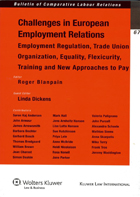Strong Trade Unions Meet EEC Workers: Locating, Monitoring and Organising EEC Workers in the Danish Construction Sector
Article by Søren Kaj Andersen & Jens Arnholtz Hansen
 Although Denmark has not experienced an increase in the number of migrant workers from Eastern Europe to same degree as the UK or Ireland, Danish unions in the construction sector are concerned that the collective bargaining system could be undermined by the presence of Eastern European Country (EEC) workers. The argument is that migrant and, in particular, posted workers' conditions of employment often are characterised by evasions of collective agreements, whether in the form of underpayment or other violations of terms and conditions specified in the agreements. However, the trade union response is not straightforward: they could pursue a strategy of surveillance and control, leading to closer cooperation with public authorities (e.g., tax and immigration authorities) in order to impose sanctions and fines on employers violating existing agreements and legislation - a strategy often met with distrust on behalf of the migrants. Or should they focus first and foremost on the workplace and aim to organise the EEC workers? Or might they be able to do both?
Although Denmark has not experienced an increase in the number of migrant workers from Eastern Europe to same degree as the UK or Ireland, Danish unions in the construction sector are concerned that the collective bargaining system could be undermined by the presence of Eastern European Country (EEC) workers. The argument is that migrant and, in particular, posted workers' conditions of employment often are characterised by evasions of collective agreements, whether in the form of underpayment or other violations of terms and conditions specified in the agreements. However, the trade union response is not straightforward: they could pursue a strategy of surveillance and control, leading to closer cooperation with public authorities (e.g., tax and immigration authorities) in order to impose sanctions and fines on employers violating existing agreements and legislation - a strategy often met with distrust on behalf of the migrants. Or should they focus first and foremost on the workplace and aim to organise the EEC workers? Or might they be able to do both?
In this article we describe problems and challenges trade unions have faced due to the presence of EEC workers in the Danish construction sector, and we analyse trade union strategies in responding to these problems and challenges. The findings presented in this article are mainly based on interviews with representatives from trade unions and employers' associations in the Danish construction sector as well as representatives from public authorities. Both central level representatives and local union branches and individual employers have been interviewed. The article is based on a research project carried out from December 2006 to December 2007 on EEC workers employed in the Danish construction sector.
In the first two sections of the article, the Danish transitional arrangement concerning EEC workers and the manner in which EEC workers enter the Danish construction sector are outlined, as well as the problems and challenges experienced by trade unions in relation to EEC workers. In the subsequent three sections, we analyse union strategies and actions aiming to tackle these problems and challenges: 1) via influencing the state, 2) in cooperation with employers' associations via the collective bargaining system and 3) through autonomous union action. Finally, we offer conclusions and point to future perspectives regarding EEC workers in the Danish construction sector.
Article in Roger Blanpain (ed.): Challenges in European Employment Relations, Bulletin of Comparative labour Relations 67, Wolters Kluwer, October 2008.
